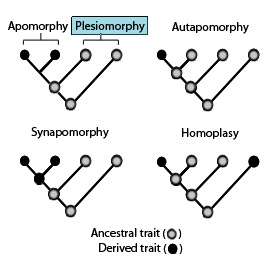Plesiomorphy and symplesiomorphy
In phylogenetics, a plesiomorphy (“near form”) is an ancestral character state. A symplesiomorphy ( from syn- “together”)[2] is a plesiomorphy shared by two or more taxa (including taxa earlier in the clade). Pseudoplesiomorphy is any trait that cannot be identified as a plesiomorphy nor as an apomorphy.[3]

Alternative terms are plesiomorphic character and symplesiomorphic character respectively, or plesiomorphic trait and symplesiomorphic trait respectively.
The term symplesiomorphy was introduced in 1950 by German entomologist Willi Hennig.
Examples

An example is hair in primates: it is plesiomorphic (ancestral) and symplesiomorphic (ancestral and present in all primates).[5]
Discussion
Plesiomorphy and symplesiomorphy correspond to apomorphy and synapomorphy which are derived trait (“evolutionary novelty”) and a shared derived trait.
All of these terms are by definition relative in that a trait can be a plesiomorphy in one context and an apomorphy in another (see example in Figure 2).
Apomorphic and synapomorphic characteristics convey much information about the evolutionary clades and can be used to define taxa. However, plesiomorphic and symplesiomorphic characteristics cannot. Species should not be grouped purely by morphologic or genetic similarity. Because a plesiomorphic character inherited from a common ancestor can appear anywhere in a phylogenetic tree, its presence does not reveal anything about the relationships within the tree.[6] Thus grouping species requires distinguishing ancestral from derived character states.[7]
An example to illustrate this is the breathing via gills in bony fish and cartilaginous fish. They share it because it was present in their common ancestor. But bony fish that breathe through their skin or lungs evolved into living vertebrates, and are more closely related to terrestrial vertebrates than to sharks and other cartilaginous fish.[8]
Another example is thermo-regulation in reptilia and birds. Reptilia are ectothermic (coldblooded) and birds are endothermic (warmblooded). This is plesiomorphic for birds and plesiomorphic for reptiles. Being coldblooded is symplesiomorphic for lizards, turtles and crocodiles, but they do not form a clade without birds, as crocodiles are more related to birds than to lizards and turtles.[9]
See also
References
- Roderick D.M. Page; Edward C. Holmes (14 July 2009). Molecular Evolution: A Phylogenetic Approach. John Wiley & Sons. ISBN 978-1-4443-1336-9.
- "Phylogenetic Systematics". Encyclopedia of Ecology and Environmental Management. John Wiley & Sons. 2009. p. 552. ISBN 978-1444313246.
- Williams, David; Schmitt, Michael; Wheeler, Quentin (2016). The Future of Phylogenetic Systematics: The Legacy of Willi Hennig. Cambridge University Press. p. 169. ISBN 978-1107117648.
- Freeman, Scott, 1955- (2015). Evolutionary analysis. Herron, Jon C., 1962- (5th ed.). Harlow. ISBN 9781292061276. OCLC 903941931.CS1 maint: multiple names: authors list (link)
- "Plesiomorphy - an overview | ScienceDirect Topics". www.sciencedirect.com. Retrieved 2019-09-19.
- Patterson, Colin (1982), "Morphological characters and homology", in Joysey, Kenneth A; Friday, A. E. (eds.), Problems in Phylogenetic Reconstruction, Systematics Association Special Volume 21, London: Academic Press, ISBN 0-12-391250-4.
- Futuyma, Douglas J. (1998), Evolutionary Biology (3rd ed.), Sunderland, Massachusetts: Sinauer Associates, Inc., p. 95, ISBN 0-87893-189-9
- Cracraft, Joel; Donoghue, Michael J. (2004), Assembling the Tree of Life, USA: Oxford University Press, p. 367, ISBN 0-19-517234-5
- Archibald, J. David (2014-08-19). Aristotle's ladder, Darwin's tree : the evolution of visual metaphors for biological order. New York. ISBN 9780231537667. OCLC 884645828.